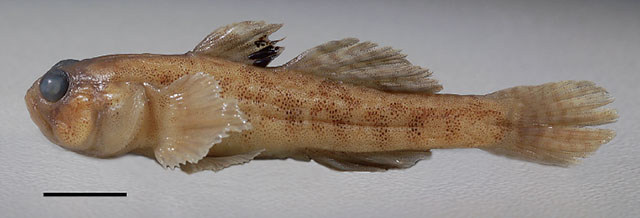| Gobiidae (Gobies), subfamily: Gobionellinae |
| 2.83 cm SL (male/unsexed) |
|
demersal; freshwater |
| Europe: River Morača, southern Montenegro. |
|
Dorsal spines (total): 7-7; Dorsal soft rays (total): 7-8; Anal spines: 1-1; Anal soft rays: 6-7. Distinguished from all congeners, except Knipowitschia croatica, Knipowitschia ephesi and Knipowitschia punctatissima, by the body squamation reduced to axillary patch and head canals absent. Can be differentiated from Knipowitschia punctatissima, Knipowitschia ephesi and Knipowitschia croatica by the following combination of characters: D1 VI; P extends back approximately to below posterior end of D1; pelvic disc with midline depth of anterior membrane 1/3-1/2 length of pelvic spinous ray; neuromast suborbital row a reaching anteriorly at maximum to below middle of eye; suborbital row b reaching anteriorly at maximum to below rear border of eye; single suborbital transverse row cp situated below beginning of row b; anterior dorsal row g shorter than distance between row g and n; and preorbital row s ending anteriorly in front of anterior end of row r p not clearly separated (Ref. 75974).
Description: V I/5+5/I (Ref. 75974). |
| Occurs in river shallows with slow current and in pools remaining in gravel pits after river flooding. The substrate consists of gravel, covered with fine sediment and overgrown by dense filamentous algae (Ref. 75974). |
|
Data deficient (DD); Date assessed: 22 August 2010 Ref. (130435)
|
| harmless |
Source and more info: www.fishbase.org. For personal, classroom, and other internal use only. Not for publication.

